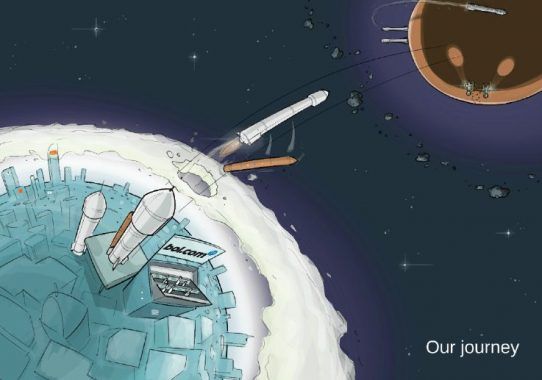Our agile journey so far - Part 1: bol.com to the moon!
From a small online book store to an e-commerce platform with 7 million customers. That’s the short version of the bol.com story so far. It’s been a tremendous journey, also from an IT perspective. Almost 10 years ago we escaped the dark ages of waterfall methodology and adopted Scrum. Even though this way of working benefited us, we realized a few years ago we had to take another major leap forward. Our IT department had grown from 10 to 50 scrum teams in only a couple of years, with 325 people according to our latest IT head count. We're no longer just a web company or an e-commerce organization. We're also an IT company. We have to be, in order to be successful in the short and in the long run.
We would like to share our growth story in a series of blog posts. These posts are written by Roy Gielen, an agile enabler who interviewed several persons at bol.com on this topic. Seeing an external opinion on our work is both interesting and useful. We want to thank him for helping us to put our story on paper and are excited that we can share our journey with you!
Bol.com to the moon
(by Roy Gielen)
Growing pains
It is obvious that bol.com is growing exponentially, especially in the last four to five years. Of course growth is good, but it also introduces growing pains: growth leads to more complexity and dependencies between systems, teams, people and features and it introduces heaps of data. At bol.com the speed of innovation is accelerating and at the same time the company needs to excel in operational excellence. The people at bol.com experience that this fast growth is a challenge regarding scalability, productivity and motivation. That leads them to the conclusion that they need to make significant changes in their way of working and the way they design, build, deploy and operate all their applications.
Going to the moon
Hence during 2015 bol.com determines and implements its own vision, based on DevOps. In the DevOps mindset developers and system operators work together in one team to be more efficient. Also, the developers have more responsibility for their products and processes. Bol.com’s own vision to become autonomous and embrace the DevOps mindset is called Man on the moon. The name is used as a metaphor for the challenging and interesting journey the company has made to team autonomy and the process is in full swing right now. ‘We had to adapt the way we work, how we organize ourselves and we invested in new technologies to ‘automize’ the (now) over 50 teams. Autonomy helps the company grow’, according to Menno.

So, did bol.com land on the moon yet? Yes, the company did make its first landing. Although not settled down just yet, it has already come a long way. Right now the last teams are moving there and the necessary applications and tools are being moved as well, to make sure it’s going to be a nice place to live. The company is also actively thinking about new ambitious ideas. Maybe it can go even further than the moon.
The importance of individuals
Clearly bol.com is in the middle of a major leap forward. The first results of this journey already prove that the company is improving continuously: user stories per team and the amount of releases are increasing, the release cycles are shorter while incidents are decreasing. Those are good results, but implementing a change is never easy. It’s not only about implementing new tools and a way of working. Just as important, or maybe even more important, is the need to be sure that you onboard individuals: they need to be willing to change and stay with you.
John Kotter’s eight-steps model
A method I always believed in and which can be used to implement changes like this is John Kotter’s eight-steps model. I guided multiple companies with organizational changes and this model has always been a great help in these processes. During a change the model cannot only be used as an approach, but also as a checklist. When walking through the bol.com journey I realized they consciously or unconsciously applied parts of this model. For me this is another confirmation of the quality of this model. Therefore, in the following posts I will compare parts of bol.com’s journey with John Kotter’s model and use bol.com as an example how to apply these steps successfully and have a successful organization change.
About the writer
Roy Gielen is an agile enabler, personal coach and change manager at Ctree BV. He is currently studying for an MBA and writes about successful responsive organizations. Thanks to this combination of skills he guides organizations and their individuals in their journey to responsiveness, keeping in mind that every change starts with the individual. He future proofs organizations so they are ready to adapt in this fast changing world.